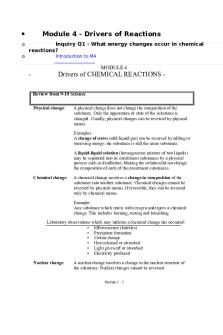Module 3 Study guide PDF

| Title | Module 3 Study guide |
|---|---|
| Course | Human Anatomy and Physiology |
| Institution | Rasmussen University |
| Pages | 2 |
| File Size | 51.1 KB |
| File Type | |
| Total Downloads | 53 |
| Total Views | 164 |
Summary
Download Module 3 Study guide PDF
Description
Module 3 Study guide
1. Identify and label major bones and their appropriate landmarks of the skeletal system? 2. Define the functions of the skeletal system? Support, protection, movement, mineral storage, hematopoiesis 3. Compare and contrast the two types of bone formation? Ossification or osteogenesis-formation of bone intramembranous ossification: produces the flat bones of the skull and part of the clavicle, compact and spongy bone develop directly from sheets of fibrous connective tissue, no cartilage is needed for this process. endochondral ossification: This process involves a cartilage bone template that is converted to bone tissue, most bones of the body develop this way, starts around the sixth week of fetal development, an epiphyseal plate if formed 4. Identify and describe the importance of the epiphyseal plates? (Growth plate)- a layer of hyaline transparent cartilage in a growing bone. Allows us to grow from infancy to adulthood.
5. Compare and contrast the factors that influence bone (matrix) homeostasis? Bones are continually remodeled throughout life by the absorption of old bone and depositing of new bone- osteoclast and osteoblast activity 6. Compare and contrast the actions of calcitonin and parathyroid hormone? 7. Define Osteopenia and Osteoporosis? Osteoporosis: Progressive condition where the BMD is very low and there is an increased risk for bone fractures Osteopenia: Bone mineral density (BMD) is lower than normal peak at bone mineral density, but not low enough to be classified as osteoporosis.
8. List and define the steps involved in bone repair? A fracture hematoma forms, fibrocartilage callus formation, bony callus formation & bone remodeling
9. Identify the anatomy of bone tissue? Osteoblast, osteocytes, and osteoclast 10. Compare and contrast bone cells?
Osteocyte- maintain mineral concentration of matrix; osteoblast-bone formation; osteogenic celldevelop into osteoblast; osteoclast-bone resorption
11. Identify the anatomy and explain the role of the components within extracellular space of bone tissue Organic matter: collagen fiber inorganic matter: hydroxyapatite 12. Compare and contrast the characteristics and anatomical structures of spongy and compact bones? Have outer layer of osteon, small function unit of bone. Canaliculi, lamellae lacuna Spongy- long bones no blood vessels, lacuna...
Similar Free PDFs

Module 3 Study Guide
- 3 Pages

Module 3 Study guide
- 2 Pages

Module 3 Study Guide LAB
- 3 Pages

Module 7 study guide
- 5 Pages

Module 5 Study Guide
- 6 Pages

Study Guide Module 6
- 5 Pages

Module 4 study guide
- 36 Pages

Module 1 study guide
- 14 Pages

Module 1 Study Guide
- 29 Pages

Module 2 Study Guide
- 6 Pages

Module 2 Study Guide
- 10 Pages

Module 2 Study Guide
- 2 Pages

Module 6 Study Guide
- 4 Pages

Module 5 Study Guide
- 14 Pages
Popular Institutions
- Tinajero National High School - Annex
- Politeknik Caltex Riau
- Yokohama City University
- SGT University
- University of Al-Qadisiyah
- Divine Word College of Vigan
- Techniek College Rotterdam
- Universidade de Santiago
- Universiti Teknologi MARA Cawangan Johor Kampus Pasir Gudang
- Poltekkes Kemenkes Yogyakarta
- Baguio City National High School
- Colegio san marcos
- preparatoria uno
- Centro de Bachillerato Tecnológico Industrial y de Servicios No. 107
- Dalian Maritime University
- Quang Trung Secondary School
- Colegio Tecnológico en Informática
- Corporación Regional de Educación Superior
- Grupo CEDVA
- Dar Al Uloom University
- Centro de Estudios Preuniversitarios de la Universidad Nacional de Ingeniería
- 上智大学
- Aakash International School, Nuna Majara
- San Felipe Neri Catholic School
- Kang Chiao International School - New Taipei City
- Misamis Occidental National High School
- Institución Educativa Escuela Normal Juan Ladrilleros
- Kolehiyo ng Pantukan
- Batanes State College
- Instituto Continental
- Sekolah Menengah Kejuruan Kesehatan Kaltara (Tarakan)
- Colegio de La Inmaculada Concepcion - Cebu

